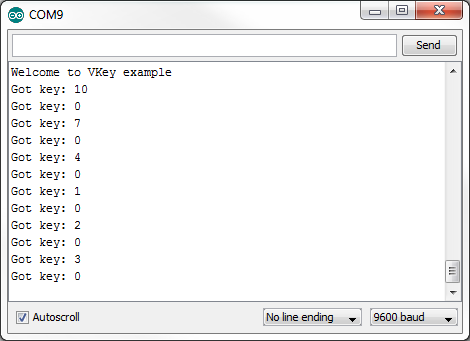VKey Voltage Keypad Hookup Guide
This Tutorial is Retired!
This tutorial covers concepts or technologies that are no longer current. It's still here for you to read and enjoy, but may not be as useful as our newest tutorials.
Example Code
Once you have installed the library, open the Arduino IDE, and paste the following into the sketch:
language:c
/******************************************************************************
VKey_demo_main.ino
VKey Voltage Keypad decoding demo
By Byron Jacquot @ @ SparkFun Electronics
February 4, 2014
https://github.com/sparkfun/VKey_Voltage_Keypad
This demonstrates interfacing the SparkFun VKey voltage keypad using
the VKey Arduino library.
The VKey has an array of 12 pushbuttons, each producing a unique analog
voltage when pushed. A microcontroller can read the voltage, and determine
which key has been pressed. The VKey library keeps track of the analog pin
connection, key status, and voltage calibration details.
The VKey was connected to the Arduino as follows:
VKey GND -> Arduino GND
VKey Vout -> Arduino analog input A1
VKey V+ -> Arduino VCC
To use the library, instantiate a VKey object and periodically check for input
using the checkKeys() function.
Resources:
no additional library requirements
Development environment specifics:
Developed on Arduino IDE 1.0.5
Tested on a 5V Redboard and 3.3V Pro Mini
This code is beerware; if you see me (or any other SparkFun employee) at the
local, and you've found our code helpful, please buy us a round!
Distributed as-is; no warranty is given.
******************************************************************************/
#include <VKey.h>
// Global declaration of the VKey class
// Initialized with analog pin number and supply voltage
VKey keypad(A1, VKey::FIVE );
void setup()
{
// Initialize serial port for text output
Serial.begin(9600);
Serial.println("Welcome to VKey example");
// No VKey specific initialization required.
}
void loop()
{
VKey::eKeynum k; // Variable to receive the key indication
/* CheckKeys will always return the current key in parameter k.
The boolean return value indicates whether that value is different than
the previous value.
*/
if(keypad.checkKeys(k))
{
// Only print when value has changed
Serial.print("Got key: ");
Serial.println(k);
}
// The responsiveness of the keypad depends on how frequently it is checked.
// 50 milliseconds seems to be a reasonable poll interval.
delay(50);
}
Build and upload the sketch. Then open a serial terminal, and observe the output while pressing buttons.
The Arduino will print notifications as buttons are pressed and released. A key number of 0 indicates that no keys are currently pressed.
If the Arduino isn't properly tracking the key numbers, double-check that the VKey object was declared with the proper analog pin and supply voltage parameters. Also doublecheck that you've got the latest code from the Github repository.
